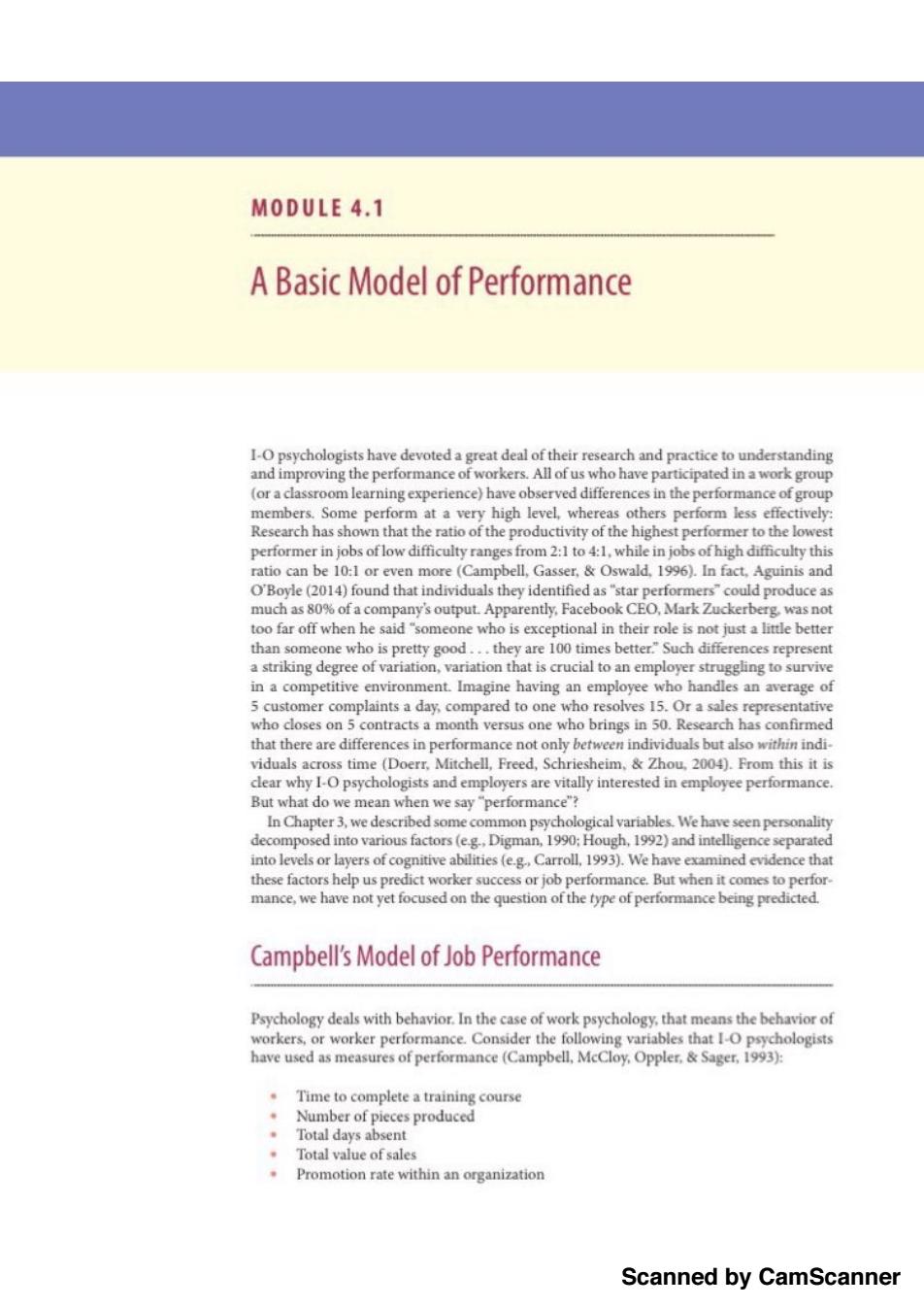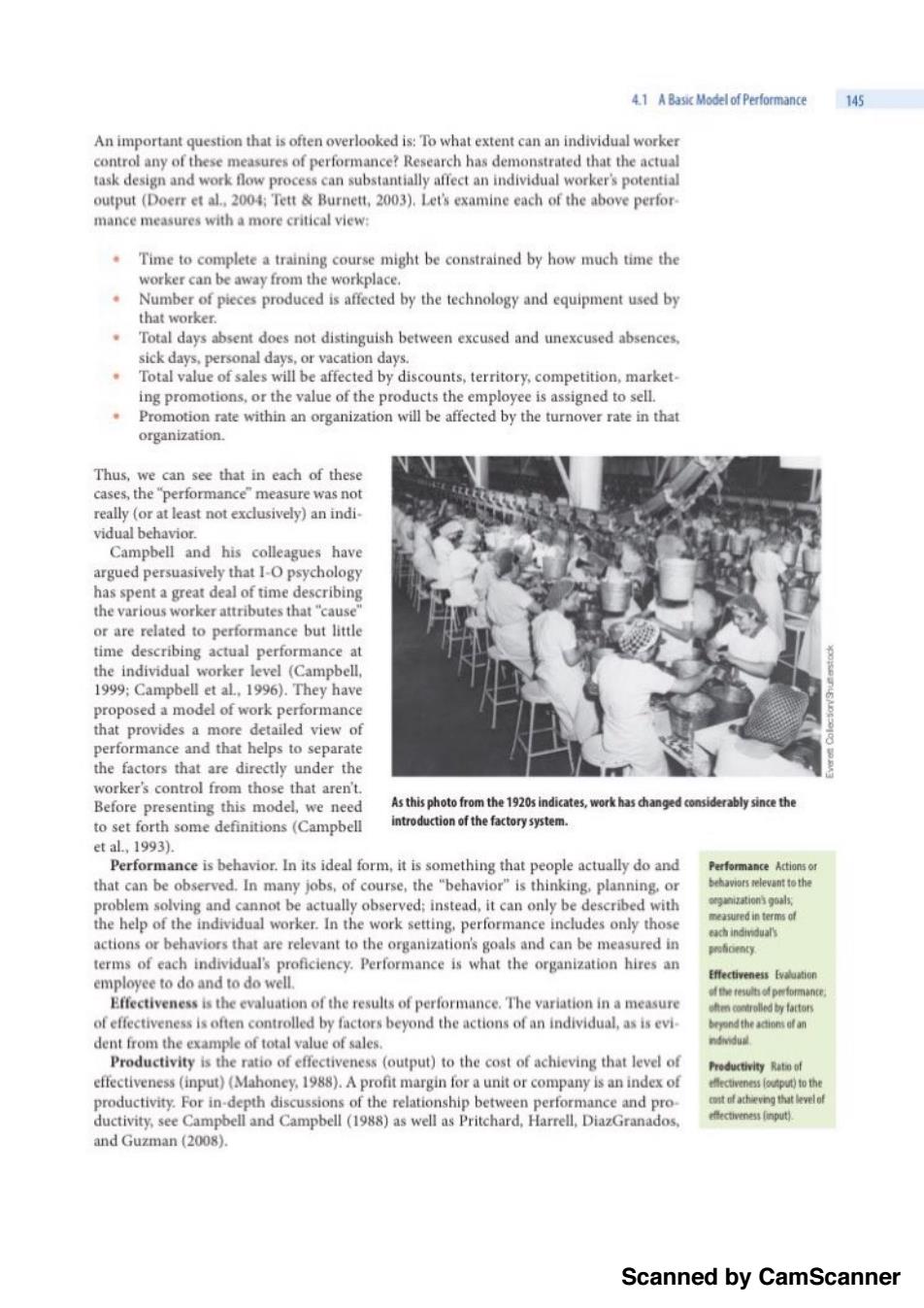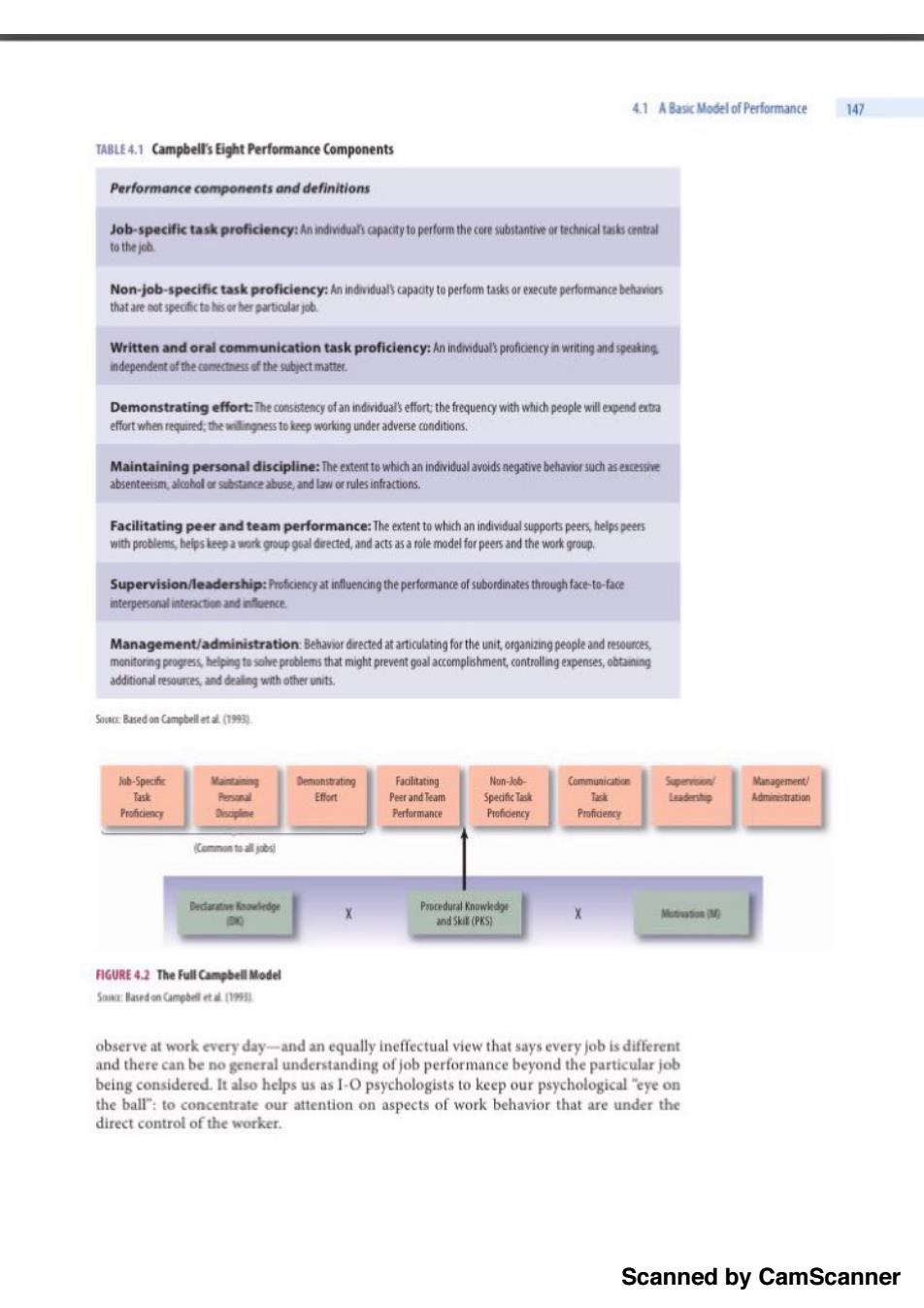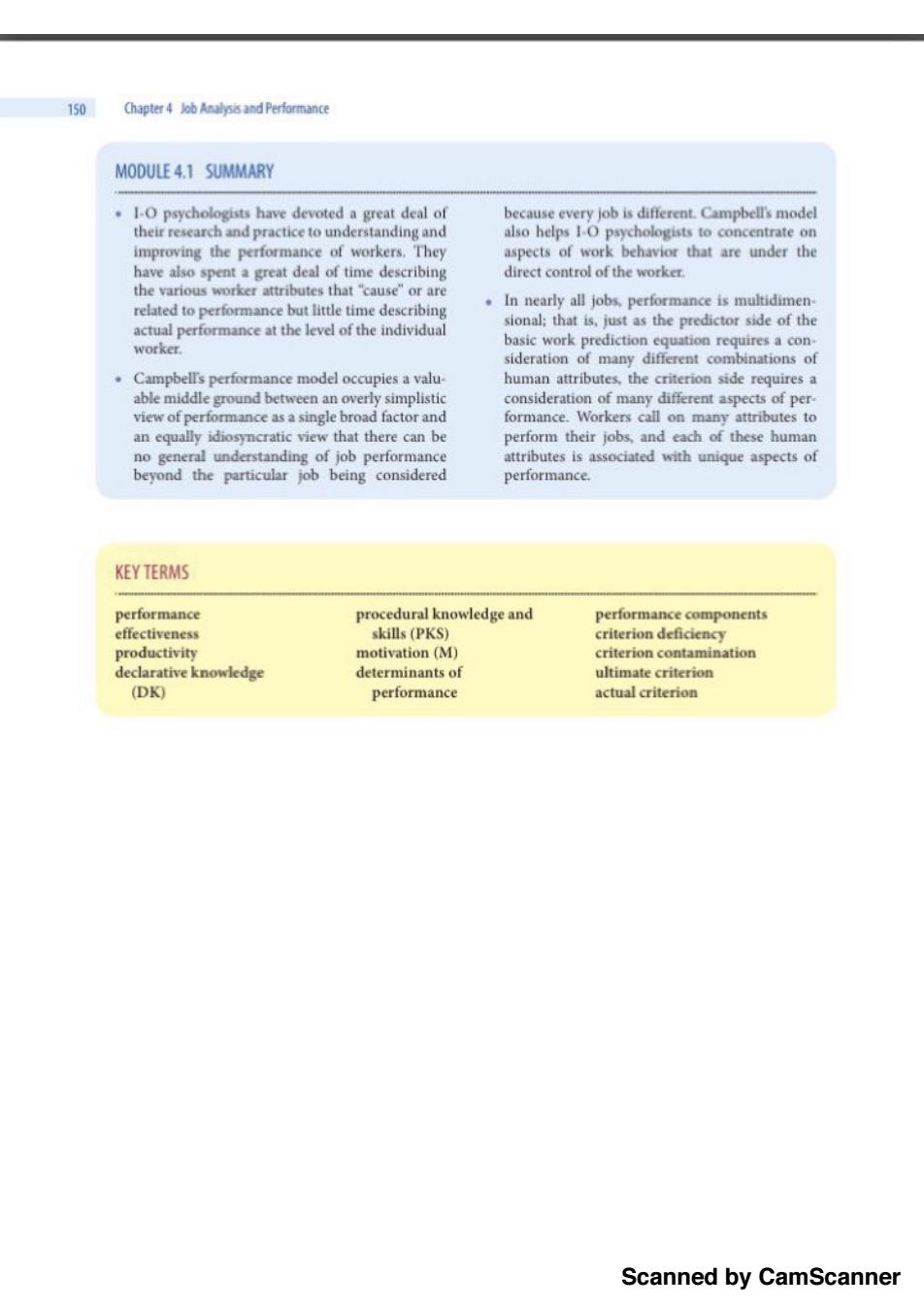
4 Job Analysis and Performance Module 4.1 A Basic Model of How Job Analysis Is Done 167 Performance 144 Work Analysis 169 Campbell's Model of Job Performance 144 Module 4.4 Job Analysis:Newer Criterion Deficiency and Contamination 149 Developments 170 Module 4.2 Extensions of the Basic Electronic Performance Monitoring as Part of Performance Model 151 a Job Analysis 170 Task Performance versus Organizational Cognitive Task Analysis 171 Citizenship Behavior 151 Personality-Based Job Analysis 172 The Dark Side of Performance: A Summary of the Job Analysis Process 172 Counterproductive Work Behaviors 154 Computer-Based Job Analysis 173 Adaptive Performance 157 0*NET173 A Brief Recap 159 Competency Modeling 175 Expert Performance 159 Module 4.5 Job Evaluation and the Types of Performance Measures 160 Law 178 Module 4.3 Job Analysis:Fundamental Job Evaluation 178 Properties and Practices 162 The Concept of Comparable Worth 179 The Uses of Job Analysis Information 162 Job Analysis and Employment Types of Job Analysis 166 Litigation 180 Scanned by CamScanner
Scanned by CamScanner

MODULE 4.1 A Basic Model of Performance 1-O psychologists have devoted a great deal of their research and practice to understanding and improving the performance of workers.All of us who have participated in a work group (or a classroom learning experience)have observed differences in the performance of group members.Some perform at a very high level,whereas others perform less effectively: Research has shown that the ratio of the productivity of the highest performer to the lowest performer in jobs of low difficulty ranges from 2:1 to 4:1,while in jobs of high difficulty this ratio can be 10:1 or even more(Campbell,Gasser,Oswald,1996).In fact,Aguinis and O'Boyle(2014)found that individuals they identified as"star performers"could produce as much as 80%of a company's output.Apparently,Facebook CEO,Mark Zuckerberg was not too far off when he said "someone who is exceptional in their role is not just a little better than someone who is pretty good...they are 100 times better."Such differences represent a striking degree of variation,variation that is crucial to an employer struggling to survive in a competitive environment.Imagine having an employee who handles an average of 5 customer complaints a day,compared to one who resolves 15.Or a sales representative who closes on 5 contracts a month versus one who brings in 50.Research has confirmed that there are differences in performance not only between individuals but also within indi- viduals across time (Doerr.Mitchell,Freed,Schriesheim.Zhou.2004).From this it is clear why I-O psychologists and employers are vitally interested in employee performance. But what do we mean when we say "performance"? In Chapter 3,we described some common psychological variables.We have seen personality decomposed into various factors(e.g.,Digman,1990:Hough,1992)and intelligence separated into levels or layers of cognitive abilities (e.g Carroll,1993).We have examined evidence that these factors help us predict worker success or job performance.But when it comes to perfor mance,we have not yet focused on the question of the type of performance being predicted. Campbell's Model of Job Performance Psychology deals with behavior.In the case of work psychology,that means the behavior of workers,or worker performance.Consider the following variables that I-O psychologists have used as measures of performance(Campbell,McCloy,Oppler.Sager,1993): Time to complete a training course Number of pieces produced Total days absent .Total value of sales Promotion rate within an organization Scanned by CamScanner
Scanned by CamScanner

4.1 A Basic Model of Performance 145 An important question that is often overlooked is:To what extent can an individual worker control any of these measures of performance?Research has demonstrated that the actual task design and work flow process can substantially affect an individual worker's potential output (Doerr et al 2004;Tett Burnett,2003).Let's examine each of the above perfor- mance measures with a more critical view: Time to complete a training course might be constrained by how much time the worker can be away from the workplace. Number of pieces produced is affected by the technology and equipment used by that worker. Total days absent does not distinguish between excused and unexcused absences, sick days,personal days,or vacation days. Total value of sales will be affected by discounts,territory,competition,market- ing promotions,or the value of the products the employee is assigned to sell. Promotion rate within an organization will be affected by the turnover rate in that organization. Thus,we can see that in each of these cases,the "performance"measure was not really (or at least not exclusively)an indi. vidual behavior. Campbell and his colleagues have argued persuasively that I-O psychology has spent a great deal of time describing the various worker attributes that cause' or are related to performance but little time describing actual performance at the individual worker level (Campbell, 1999;Campbell et al.,1996).They have proposed a model of work performance that provides a more detailed view of performance and that helps to separate the factors that are directly under the worker's control from those that aren't. Before presenting this model,we need As this photo from the 1920s indicates,work has changed considerably since the to set forth some definitions(Campbell introduction of the factory system. etal,1993). Performance is behavior.In its ideal form,it is something that people actually do and Performance Actions or that can be observed.In many jobs,of course,the "behavior"is thinking,planning.or behaviors elevant tothe problem solving and cannot be actually observed;instead,it can only be described with eganization goals the help of the individual worker.In the work setting.performance includes only those easured i销emG ach indidual小 actions or behaviors that are relevant to the organization's goals and can be measured in preficenty terms of each individual's proficiency.Performance is what the organization hires an employee to do and to do well. Effectiveness Evaluation hresultof pformnce Effectiveness is the evaluation of the results of performance.The variation in a measure coredbyfartors of effectiveness is often controlled by factors beyond the actions of an individual,as is evi- beyond the actinns af an dent from the example of total value of sales. Productivity is the ratio of effectiveness (output)to the cost of achieving that level of Preductivity Ratio o! effectiveness (input)(Mahoney,1988).A profit margin for a unit or company is an index of ectiveness fouput)to the productivity.For in-depth discussions of the relationship between performance and pro- ofachieving that levelo ductivity,see Campbell and Campbell(1988)as well as Pritchard,Harrell,DiazGranados, fectiveness (mput) and Guzman(2008). Scanned by CamScanner
Scanned by CamScanner

146 Chapter4 Job Analysis and Performance Dedarative Knowledge (DK): Procedural Knowledge and Knowledge about facts and Sk作Pg5 )Knowing how to thngs an understanding of a dohn华 先键性t仇uan线e fat由 Choketo perfomm 向kaah Levelof effort G当 Self-management skill Prrsistence of etfort Sel-kowledge y fomn Theory 月GURE4.1 Campbell Determinants of Job Performance Sou:Based on Campbel 时(19931 Based on extensive research with army enlisted personnel,Campbell developed a hierarchical model of job performance(Campbell,McHenry,Wise,1990).He pos- Dedarative knowledge tulated three direct determinants of job performance:declarative knowledge (DK). D相Understanding what is procedural knowledge and skill(PKS),and motivation(M)(see Figure 4.1).By deter. equr时如perform a task minants,he means the basic building blocks or causes of performance. knowing informaticn abeut a ob or task Campbell's model also proposes that many of the variables we examined in earlier chapters and will examine in later chapters (ability.personality.interest,training Procedural knowledge and experience,motivators)have an indirect effect on performance.These variables and skill (PKS)Knowing how to perfamm a job ce can affect performance only by changing the level of DK.PKS,or M.For example task:often developed increased training or experience will affect performance by increasing DK or PKS; through practice and incentives for performance will affect performance by increasing M (inducing the experence person to perform at a higher level or to perform for a longer period of time).Similarly. Motivation (M)Concerns Tett and Burnett(2003)propose that personality,in particular conscientiousness,has a the condtons他spons恤 substantial effect on goal setting,which in turn increases declarative knowledge.They for variationsin intens suggest that this connection explains the finding (noted in Chapter 3)that con. p桌ynd drection of ongoing scientiousness has strong and positive correlations with job performance(Barrick behanor. Mount,1991,2005). There is one other important aspect to Campbell's model:actual performance compo- Determinants of performance Basic nents.DK,PKS,and M are determinants of performance,but they are not behaviors bulding bleckscausesf (i.e.they are not performance itself).Campbell's research identified eight basic performan统which are performance components (Table 4.1),some or all of which can be found in every job. dedaratve knawledge. When we combine the eight performance components with the three direct determinants proceduralknowledge.and of performance and the various indirect determinants of performance,we get an metiation. expanded model such as the one depicted in Figure 4.2.Although the model specifies Performance components eight distinct performance components,not all components will appear in all jobs. Component的atm尊 Nevertheless,the model allows performance in any job to be broken into all or some subsets of these components.Campbell asserted that three of the performance esult fom the determin.an站 components-core task proficiency,demonstrating effort,and maintaining personal discipline-are essential at some level for every job. Campbell's expanded model has a great deal of intuitive appeal as well as research sup- port(McCloy,Campbell,Cudek,1994).It occupies a valuable middle ground between found in every job a view of performance as a single broad factor-a view that contradicts what we can Scanned by CamScanner
Scanned by CamScanner

4.1 A Basic Model of Performance 147 TABLE4.1 Campbell's Eight Performance Components Performance components and definitions Job-specific task proficiency:An individual's capacity to perform the core substantive or technical tasks central to the jo地 Non-job-specific task proficiency:An indiiduals capaaty to perfomm tasks or execute perfommance behavers that are not specificte his er her particular job. Written and oral communication task proficiency:An indnidual's proficency in writing and speaking independent of the cmectness of the subiect matter. Demonstrating effort:The cosy of an indvidualseffort the frequency with which people will expendea effort when required theess to keep working under adverse conditions. Maintaining personal discipline:The extenttowhich an indvidualavodsnegative behavors absenteeism alcoholrtne abuse,and law or rules infractions. Facilitating peer and team performance:The extent to which an individual supports peers,helps peers withproblemhelpsedected,and acts asa role model for peersand the workgroup Supervision/leadership:Proficiency at influencing the performance of subordinates through face-to-face nterpersonal interaction and infuence Management/administration:Behavior drected at articulating for the unit,organizing people and resoues mepsve prblems that might prevent goalaccomplshment,controlng expenses dditional resources and dealing with other units SuEB超ed on Campbellet Job-Specific Faolitating Non-lb- Communicatce Management/ Task Effort Peerand Team Specific Task a Performance Profioency Profidency Decarate Kouedg Procedural Knowldoe 趋d5 k(PKS) Mueuton FIGURE 4.2 The Full Campbell Model Sama:Based on Camobell eta993 observe at work every day-and an equally ineffectual view that says every job is different and there can be no general understanding of job performance beyond the particular job being considered.It also helps us as I-O psychologists to keep our psychological "eye on the ball":to concentrate our attention on aspects of work behavior that are under the direct control of the worker. Scanned by CamScanner
Scanned by CamScanner

148 Chapter4 Job Analysis and Performance Typical versus Maximum Performance 1-0 psychologists make a distinction between "typical"and "maximum"performance (DuBois,Sackett.Zedeck,Fogli,1993:Sackett.2007).Typical performance might be characterized by a worker putting in 70 percent effort for eight hours;maximum performance,in contrast,might be that same worker putting in 100 percent effort for four (or even eight!)hours.The implication is that these are somehow different types of performance.Maximum performance can be thought of as the very best a person can do-exerting 100 percent effort,leaving nothing in reserve.Typical performance is everything else.The question is whether the predictors of typical performance are also the predictors of maximum performance.Furthermore,it is not clear how long a worker can demonstrate maximum performance.Consider the pressures on postal and courier drivers in the days leading up to Christmas-or the deadly urgency with which wildland firefighters work,putting in several consecutive 20-hour days struggling to get a fire under control.When first introduced as a concept by Sackett and colleagues (1988).maximum performance was thought to be controlled largely by abilities (e.g.,intelligence)and typical perfor. mance by a combination of ability and motivation.In 2007.a special issue of the journal Human Performance was devoted to a consideration of maximum versus typical performance.Some of the conclusions from that special issue are summarized in Table 4.2;as you can see,they provide support for Sackett's interpretations.More recently,Beus and Whitman (2012)conducted a meta- analysis and found a moderate asso. ciation between typical and maximum performance(r=+.42),indicating that a meaningful distinction does indeed exist.They also found that cognitive ability was more strongly related to Fighting wildland fires can require maximum performance for hours or even days at maximum than typical performance. a stretch. TABLE 4.2 Maximum versus Typical Performance 1.Goal setting is effective in inducing maximum performance (Mesmer-Magnus 2007 2.Lconfdence undermines maximum perfomance(Klehe,AnderonHo2007) 3. When perfommance is complex(many competing demands),the most mporadby theo) areas usually display aspects of maximum performance while less important areasusudspay aspects of typical performance (Mangos,Steele-Johnson,LaHuis,&White,2007) 4. The vanability between typical and maximum levels of perfomanceithnneortanaspect of performance from the organizational perspective (Barnes &Morgeson.2007). Mamum performane is influenced by coitive abityand formalknowedge(den the Campbell model),whereas typical performance is influenced by personay(he2007 Spizmuller2007力. eu5 from Humon Pert6mn2007,olume0h.3 Scanned by CamScanner
Scanned by CamScanner

4.1 A Basic Model of Performance 149 Criterion Deficiency and Contamination Campbell's approach to defining job performance introduces two concepts that are well established in I-O psychology:criterion deficiency and criterion contamination.Let's Criterion deficency A start with a simple nonpsychological example.Consider the dietary supplement omega-3. sation that occurs when an essential fatty acid found in fish oil that has been linked with positive health outcomes anactual cnteron is missing such as a reduction in cardiac disease and improved emotional well-being.Let's suppose nformation tha试每part of thebelavor ane is trying to that a new manufacturer of omega-3 claims that its supplement is"pure"omega-3.To most measure. of us that would mean that it is 100 percent omega-3.Now let's give it to a chemist and see whether it meets the purity claim.The results tell us that it is not 100 percent omega-3;it is Criterion contamination Aonh国atU时Wn only 80 percent fish oil,with the remaining 20 percent made up of a stimulant such as an actual indludes ephedrine.This supplement would be both deficient(it did not contain as much omega-3 as it claimed)and contaminated (it contained 20 percent ephedrine).If we really just wanted omega-3,we would be well advised to purchase a different brand that was truly 100 percent omega-3(neither deficient nor contaminated). Ultimate citerion As you will recognize from our treatment of validity in Chapter 2,in the validity (Theoretical ariterion) context,performance would be referred to as a criterion.In an ideal world,we would be 块dma5 ure of all the elevant aspects of job able to measure all relevant aspects of job performance perfectly.A collective measure of performance. all of these aspects would be called the ultimate criterion(theoretical criterion),but since we can never reliably measure all aspects of performance,we settle for an actual Actual criterion Actual eafb世ormance criterion.A classic validity study might test cognitive ability (the predictor)by correlating it with a measure of job performance(the actual criterion,e.g.,supervisory ratings of performance)to see if higher scores on the test are associated with higher levels of rated performance.The differences between the ultimate criterion and the actual criterion represent imperfections in measurement-contamination and deficiency. A contaminated actual criterion includes information unrelated to the behavior we are trying to measure.For example,if a production figure for an individual worker is affected by the technology or the condition of the particular machine that worker is using,then we would consider that production figure (i.e.,criterion)contaminated.Similarly,if we consider the performance of a police officer to be defined exclusively by the number of criminals apprehended,ignoring many other important aspects of the police officer's job,then that statistic would be considered a deficient criterion.The relationships among criterion deficiency.criterion contamination,and criterion relevance are graphically presented in Figure 4.3. Campbell's model of performance,by focusing on worker behaviors and the extent to which the worker has complete Cnteronreevance control over outcomes,protects against criterion contamina- tion.Similarly,by providing eight of the most important and unique aspects of performance in most jobs,it also protects against criterion deficiency.It is important to keep in mind that probably not a single job has only one behavior that defines successful performance.Just as the predictor side of the basic work prediction equation is complex-requiring a consideration of many different combinations of human attributes such as intelligence,personality,and motivation- so is the criterion side,requiring a consideration of many different aspects of performance.Workers call on many Crterion contamination attributes to perform their jobs,and each of these human Cniterion deficency attributes (predictors)is associated with certain aspects of FIGURE 4.3 Criterion Contamination,Deficiency,and performance. Relevance Scanned by CamScanner
Scanned by CamScanner

150 Chapter 4 lob Analypsisand Performance MODULE 4.1 SUMMARY .1-0 psychologists have devoted a great deal of because every job is different.Campbell's model their research and practice to understanding and also helps I-O psychologists to concentrate on improving the performance of workers.They aspects of work behavior that are under the have also spent a great deal of time describing direct control of the worker the various worker attributes that 'cause"or are In nearly all jobs,performance is multidimen. related to performance but little time describing actual performance at the level of the individual sional;that is,just as the predictor side of the worker. basic work prediction equation requires a con sideration of many different combinations of Campbell's performance model occupies a valu- human attributes,the criterion side requires a able middle ground between an overly simplistic consideration of many different aspects of per. view of performance as a single broad factor and formance.Workers call on many attributes to an equally idiosyncratic view that there can be perform their jobs,and each of these human no general understanding of job performance attributes is associated with unique aspects of beyond the particular job being considered performance. KEY TERMS performance procedural knowledge and performance components effectiveness skills (PKS) criterion deficiency productivity motivation(M) criterion contamination declarative knowledge determinants of ultimate criterion (DK) performance actual criterion Scanned by CamScanner
Scanned by CamScanner

MODULE 4.2 Extensions of the Basic Performance Model Task Performance versus Organizational Citizenship Behavior When performance is discussed,it is usually in the context of one or more tasks that define a job.These tasks can be found in job descriptions,training materials,and so forth. But there is more to work life than just assigned tasks.You have probably observed that. when it comes to job performance,there are two kinds of workers.The first do exactly what they are assigned and no more.They avoid putting themselves out for co-workers or expending any extra effort on behalf of the organization.The second type of worker is the exact opposite.These workers go out of their way to make life easier for their co-workers and supervisor,with the result that they are often described as "exceeding expectations." The term"expectations"is the key.It is not that the first type of employee is doing any- thing wrong.Why should you do anything beyond the expectations set forth in your job description?But we can observe that some people do exceed expectations. A number of years ago,Organ and his colleagues(Smith,Organ,Near,1983)labeled this type of behavior-going beyond what is expected-organizational citizenship behavior Organizational (OCB)and developed questionnaires to assess that behavior in workers.The question- ctizenship behavior (0CB) naires seem to assess two separate aspects of OCB,altruism-helpful behaviors directed Behavior that gors beyond toward individuals or groups within the organization,such as offering to help a co-worker h时书xpected who is up against a deadline-and generalized compliance-behavior that is helpful to the Altruism Helpfu behavioe broader organization,such as upholding company rules(Organ Ryan,1995). deced toward individuals It appears that OCB is closely associated with the fact that work is a joint rather than an e事hnhe angation,suh封ofeg individual effort.As an example,Bachrach,Powell,Bendoly,and Richey (2006)found that to help aco-worker who书 OCB was considered more important when work tasks required collaboration among 甲n时deadline. workers or within work teams.It does seem that OCB is largely a social phenomenon. Generalized compliance Borman and Motowidlo (1993)continued this line of research,investigating extra-role Beavor thats helpfial to behavior (ie.,behavior that goes beyond the job description).which they contrasted with thebrader organization. task performance.The generally accepted term for research in this area is OCB(Borman. 绿hashaldi6 company 2004).Task performance is defined as"the proficiency with which job incumbents perform activities that are formally recognized as a part of their job"(Borman Motowidlo,1993. Task performance p.73).OCB,in contrast,is more informal and is defined as"behaviors that go beyond task PrScency with which job performance and technical proficiency,instead supporting the organizational,social,and ncmbe电perform activitie psychological context that serves as the critical catalyst for tasks to be accomplished" tare fomaly cozed 益aae独h (Borman,2004,p.238). Scanned by CamScanner
Scanned by CamScanner

152 Chapter4 Job Analysis and Performance In Chapter 3,we saw the emergence of measures of personality and emotional inte- lligence as the new "favorite"predictor variables to study.OCB,similarly.is the new "favorite"measure of performance to be studied by I-O psychologists.Borman (2004) suggests that the increase in interest in OCB may be the result of current trends"such as increased global competition,greater use of teams,continuing downsizing initiatives, and more emphasis on customer service"(p.238).A more instrumental logic is proposed by Salamon and Deutsch(2006);they suggest that employees use OCB to get noticed by managers and signal their"unobserveable capabilities."Luthans(2002)suggests another possible reason for the interest in OCB.He proposes that we may be seeing a trend toward emphasizing the more positive aspects of the work experience rather than the more neutral (task performance)or negative (counterproductive work performance) ones."Positive psychology"is making inroads in virtually all areas of applied psycho- logy(Seligman Csikszentmihalyi,2000),so it is encouraging to see it reflected in the work of 1-0 psychologists.This interest parallels our earlier discussion of "good work" in Chapter 1. In the earlier periods of research on OCB,Peterson and colleagues (1990)demon- strated that while measures of cognitive ability are most closely associated with task per- formance,measures of personality do a better job of predicting OCB.Motowidlo, Borman,and Schmit(1997)provided a theoretical explanation of the personal attributes that appear to contribute to OCB and task performance.They proposed that technical task performance is determined by cognitive ability,predominantly through the effect of cognitive ability on knowledge,skills,and habits.Cognitive ability becomes particularly important in technically complex tasks and tasks requiring problem solving and reason- ing.In contrast,OCB is best predicted by personality dimensions,particularly conscien- tiousness,because individuals high in conscientiousness are much more likely to persist with extra effort in completing their work and following organizational rules and proce- dures.We alluded to this distinction earlier in the chapter when we introduced the notion of typical versus maximum performance.Researchers have also proposed that learning experiences will influence both task performance and OCB.Van Scotter, Motowidlo,and Cross(2000)demonstrated that both OCB and task performance con- tribute independently to career success,and Motowidlo and Van Scotter (1994)found that OCB and task performance contributed independently to ratings of overall perfor. mance.This latter point is particularly interesting because it shows that evaluations are influenced not only by what workers are assigned to do but also by what they volunteer to do.While all of these findings anticipated later findings,they gave little recognition to the role of the environment in the emergence of OCB.As we will see below,current research on OCB is including environmental variables such as task design and organiza- tional climate.This is a good example of the increasing importance of meso-research. which we described in Chapter 2. As is the case with many variables of interest to 1-0 psychology,early research has centered on the meaning and application of the concept in U.S.settings.Nevertheless, the increasing globalization of work has led to research in many different cultures to see if OCB might be a universal aspect of work performance,one that cuts across cultures. So far,research has been reported with Mexican (Tierney,Bauer.Potter,2002). Nigerian(Ehigie Otukoya,2005).Chinese(Hui,Lee,Rousseau,2004),Australian (Feather Rauter,2004).and Dutch/Belgian (Lievens Anseel.2004)samples. Joireman,Kamdar,Daniels,and Duell (2006)found that OCB appeared more fre. quently among individuals with a longer-term time horizon.Recall from Chapter I that many Asian cultures are characterized by a long-term time orientation.Thus,we can hypothesize that OCBs may have a higher value and a higher frequency in these cul- tures.In contrast,it may be more remarkable to see OCBs in cultures (such as the Scanned by CamScanner
Scanned by CamScanner